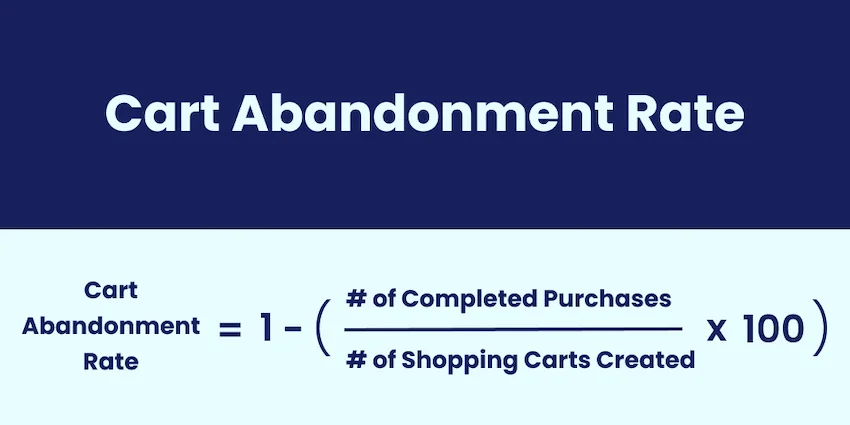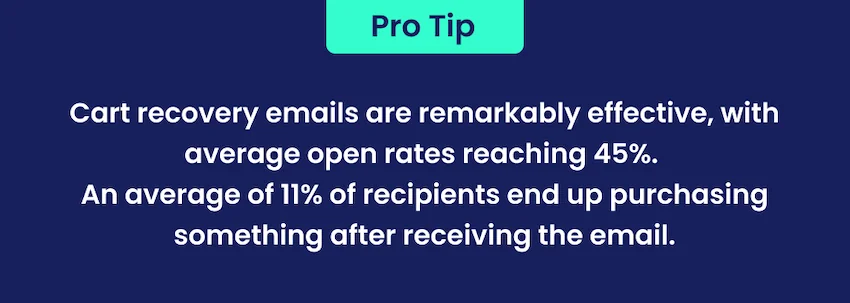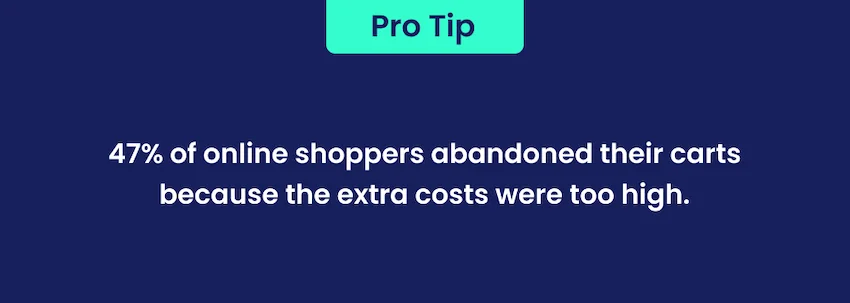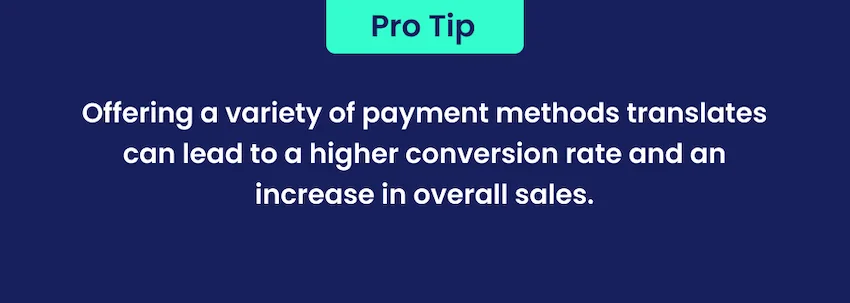Cart abandonment, or when potential customers add an item to their cart but leave your website before checking out, is a common issue for eCommerce sellers. Watching potential sales vanish at the last stage can be incredibly frustrating. But have no fear; with the right strategies, you can win back customers and turn those abandoned carts into completed sales.
While it might seem like cart abandonment is an inevitable problem, there are effective solutions that can help you tackle it head-on. Many of them are simple and easy to implement, too. By understanding the real reasons behind cart abandonment, you can turn those almost-sales into confirmed purchases.
In this comprehensive guide, we will discuss five highly-effective solutions to help you significantly reduce cart abandonment rates and increase your conversions. These include:
- Set up automated retargeting campaigns
- Enhance your online store’s user experience
- Be upfront with shipping and other costs at checkout
- Offer a variety of payment methods
- Prioritize a seamless shopping experience
Read on to turn around abandoned carts and reclaim your lost sales.
Cart Abandonment Basics
Cart abandonment is a widespread problem. In fact, the global cart abandonment rate is nearly 70%! That means that nearly three out of every four potential customers don’t complete their purchases.
You can easily calculate your own store’s cart abandonment rate.
First calculate your cart conversion rate by dividing the number of completed purchases by the number of shopping carts initiated and multiplying by 100.
Then, to get your cart abandonment rate, subtract your cart conversion rate from 1.

While cart abandonment is in part unavoidable since many consumers enjoy browsing online with no intention of making a purchase, you can still win back a large portion of those abandoned carts. In order to do so, it can help to understand why customers abandon their carts in the first place.
Through research, we know customers abandon carts for a few key reasons:
- Unexpected costs or extra fees (i.e. shipping or tax)
- Low purchase intent (i.e. researching product or just browsing)
- Overly long or complex checkout process
- Slow shipping
- Lack of trust in website
- Requires account creation
How To Reduce Your Cart Abandonment Rate
Once you understand the reasons for cart abandonment, you can implement strategies to lower your cart abandonment rates. As you try out the following strategies, you’ll also want to regularly calculate your cart abandonment rate to see what works and what doesn’t.
1. Implement retargeting campaigns
Often, shoppers simply need an extra nudge to complete their purchase. Retargeting campaigns are an excellent way to reconnect with customers and encourage them to complete their purchase.

Here’s the playbook for retargeting customers who have visited your website but haven’t made a purchase:
- Email campaigns: Send personalized reminder emails to gently notify customers about items still waiting in their carts. These emails are particularly effective, with average open rates at a whopping 45%. Even better, an average of 11% of recipients end up purchasing something as a result. Include relevant images, descriptions, or reviews of abandoned products to spark their interest again. You may also want to include a special deal or coupon code to give customers that extra push. Top email services like Klaviyo allow automating these emails based on previous site visits and cart activity. The key is having the customer’s email. So, motivate sign-ups and capture emails at checkout.
- Online ads: Platforms like Google and Facebook enable targeted ads based on user website activity. Their tracking pixels recognize past visitors or those who added items to carts. You can then display reminder ads urging them to complete purchases. The benefit that targeted ads have over email is that no email address is needed. The platforms simply identify and target previous shoppers using pixels, code that tracks web users’ browsing activity. Well-designed and dynamic ads can entice customers to re-engage and finalize transactions.
Don’t wait too long, though. Properly timed and relevant messaging can successfully convert abandoned carts into sales.
Along with a reminder, share exclusive offers and discounts or recommend additional products similar to those they viewed on your site. This provides an incentive for them to finalize their purchase.
2. Improve user experience by optimizing the checkout process
An intuitive, seamless checkout process is key to a positive shopping experience. One of the top reasons that potential customers abandon their carts is that the checkout process is too long or complex. Therefore, streamlining your checkout process is an easy way to improve your cart abandonment rate.
Ways to enhance checkout include:
- Optimize Product Listings: Make the process of viewing products and adding them to the cart as seamless as possible. Your product listings should include all relevant information about the product and high-quality images from various angles. Consider including videos to showcase the product in action.
- Enable Guest Checkouts: Allow customers to complete their purchases without the need to create an account. Offering guest checkouts can significantly reduce the chances of abandonment.
- Make the checkout process as short and user-friendly as possible: Don’t give customers the chance to second guess their purchase. Shorten the checkout process and make sure it’s intuitive and easy to navigate.
Even small tweaks like these can significantly reduce abandonment. For example, nearly 24% of online shoppers abandon their carts because they are asked to create an account.
The key is assessing pain points in your checkout experience and eliminating unnecessary hurdles between customers and purchase completion. With less friction, you’ll see more carts reaching the finish line.
3. Clearly highlight all costs upfront
According to the study by the Baymard Institute, a significant 47% of online shoppers abandoned their carts because the extra costs were too high, and 17% of online shoppers decided to leave their carts behind simply because they don’t see the total order cost upfront.

Customers value transparency. Hidden fees popping up at the last minute erode trust quickly, so being upfront is key. Here is how you can win the trust of your customers and convert more sales:
- Show all costs upfront: Prominently display the full price, including shipping, taxes, and fees early in the checkout process.
- Add a shipping cost calculator: Let customers estimate shipping by entering their zip code or address. Provide this on product pages or in the cart for clarity.
- Explain variable pricing: If taxes or costs depend on factors like location, share why and how prices may vary. Full transparency maintains trust.
- Offer alternatives: If possible, provide multiple shipping options with varying costs and delivery times. This allows customers to choose what suits them best, whether they prefer fast delivery or a more economical option.
Transparent, detailed pricing communicates honesty. It’s yet another simple but effective solution to cart abandonments.
4. Offer diverse payment solutions
Ensure your checkout process includes all popular payment methods, such as PayPal, Apple Pay, and Google Pay.
Having diverse payment options is more than just a customer service perk or a ‘nice-to-have’; it’s a serious strategic move. Giving customers their preferred payment methods can increase conversion rates by a whopping 30% – which is a great result for something relatively simple to implement.
Having multiple payment methods is important for two primary reasons:
- Improves customer convenience: Everyone has their own preferred way of paying online. By offering a variety of options, you ensure that customers can pick what’s most convenient for them, making the payment process smooth and hassle-free.
- Makes customers feel secure: Recognizable payment options can offer a sense of security. If customers see familiar and trusted payment methods, they are more likely to feel secure about completing the transaction. It signals that your eCommerce platform is reputable and aligned with known financial services.

The data speaks for itself – providing diverse payment options directly translates to higher conversion rates and more sales for your business. It’s a win-win tactic that can significantly boost your bottom line.
5. Ensure a seamless shopping experience for customers
Every aspect of the shopping experience counts, from the quality of your products to the ease with which customers can navigate your site. Improving the overall experience increases the likelihood that visitors will make a purchase.
Here are some actionable steps that anybody can take to enhance their shopping experience and reduce shopping cart abandonment.
Have a clear and favorable return and refund policy: Not having an adequate returns policy in place is a cause of cart abandonment. Make sure consumers can find and understand your return policy, and that it answers their needs.
Ensure consistent product quality: Regularly assess and improve your products. A great product is the foundation of any successful eCommerce venture.
Create an active feedback loop: Encourage and value feedback from your customers. Whether it’s praise, suggestions, or criticism, each piece of feedback is an opportunity to improve. Responding to feedback also shows customers that you value their opinion, which builds trust.
Make sure it’s easy to navigate: Your eCommerce website should be user-friendly. This means intuitive design and clear calls to action. It should be easy for customers to find the product they’re looking for, add it to their cart, and check out.
Stay informed: The digital landscape is constantly evolving, as are consumer preferences. By keeping up-to-date with the latest industry trends and technological innovations, you can anticipate changes and adapt accordingly.
Implement top-notch customer service: Give customers someone to talk to, whether it’s an AI chatbot or a phone number. Good customer service improves their overall experience and boosts your brand image.
By consistently delivering exceptional, personalized experiences, your customers will be more likely to complete their purchases. Not only will your conversion rate improve, but you will build a base of loyal customers who keep coming back to your brand.
In Conclusion
There are a number of simple, actionable tactics you can use to get customers to follow through on their purchases and lower cart abandonment. These include:
- Lure back abandoned carts with targeted campaigns
- Streamline the checkout process
- Show all costs upfront
- Give customers plenty of payment options
- Ensure a smooth and enjoyable shopping experience
Do all that, and you’ll be on the right track for success.
Remember – as demand grows, it’s important to have enough inventory on hand to fill your orders. Running out of stock can halt the progress you’ve been working hard to make.
If you, like many other successful eCommerce sellers, need a bit of extra capital to stock up on inventory, check out 8fig’s eCommerce financing solution. 8fig provides eCommerce business owners with fast, equity-free, and flexible funding aligned to your supply chain. You’ll get continuous cash injections designed to optimize your cash flow and ensure you have the capital you need on hand when you need it.
Sign up for 8fig funding today and find out how we can help you reach your full potential.
to our blog
Read the latest
from 8fig

From AI-powered styling to virtual try-ons, learn about the innovations transforming the fashion industry and enhancing the shopping experience.

Explore the pros and cons of lump sum loans vs. just-in-time funding, and discover why JIT funding could be the game-changer your eCommerce business needs.
![BFCM: The ultimate guide to eCommerce sales [2024]](https://www.8fig.co/wp-content/uploads/2023/09/cover-2-768x432.jpg.webp)
Get ready for Black Friday and Cyber Monday with our guide on maximizing sales through smart inventory management, effective marketing strategies, and leveraging eCommerce financing.
